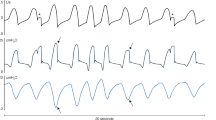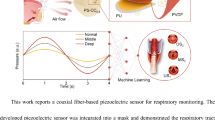Abstract
This paper considers the composition and function of sensory systems monitoring H2O2 level by the lung neuroepithelial cells and carotid bodies. These systems are localized in the plasma membrane of the corresponding cells and are composed of O 2• -generating NADPH-oxidase and an H2O2-activated K+ channel. This complex structure of the H2O2 sensors is probably due to their function in antioxidant defense. By means of these sensors, an increase in the H2O2 level in lung or blood results in a decrease in lung ventilation and constriction of blood vessels. This action lowers the O2 flux to the tissues and, hence, intracellular [O2]. The [O2] decrease, in turn, inhibits intracellular generation of reactive oxygen species. The possible roles of such systems under normal conditions (e.g., the effect of O 2• in air) and in some pathologies (e.g., pneumonia) is discussed.
Similar content being viewed by others
REFERENCES
Skulachev, V. P. (1995) Mol. Biol. (Moscow), 29, 709–715.
Skulachev, V. P. (2000) Oxygen and Programmed Death Phenomenon. First Severin Lecture [in Russian], Russian Biochemical Society, Moscow.
Skulachev, V. P. (1999) Mol. Asp. Med., 20, 139–184.
Skulachev, V. P. (1994) Biochemistry (Moscow), 59, 1433–1434.
Skulachev, V. P. (1996) Quart. Rev. Biophys., 29, 169–202.
Lopez-Barneo, J. (1994) Trends Neurosci., 17, 133–134.
Fu, X. W., Wang, D., Nurse, C. A., Dinauer, M. C., and Cutz, E. (2000) Proc. Natl. Acad. Sci. USA, 97, 4374–4379.
Wang, D., Youngson, C., Wong, V., Yeger, H., Dinauer, M. C., de Miera, E. V.-S., Rudy, B., and Cutz, E. (1996) Proc. Natl. Acad. Sci. USA, 93, 13182–13187.
Youngson, C., Nurse, C., Yeger, H., and Cutz, E. (1993) Nature, 365, 153–155.
Wyatt, C. N., Wright, C., Bee, D., and Peers, C. (1995) Proc. Natl. Acad. Sci. USA, 92, 295–299.
Jones, O. T. G., and Hancock, J. T. (2000) in Free Radicals and Inflammation Winyard, P. G., Blake, D. R., and Evans, C. H., eds.) Birkhauser Verlag, Basel, pp. 19–44.
Hou, S., Larsen, R. W., Boudko, D., Rilley, C. W., Karatan, E., Zimmer, M., Ordal, G. W., and Alam, M. (2000) Nature, 403, 540–543.
Semenza, G. (1999) Cell, 98, 281–284.
Duchen, M. R. (1999) J. Physiol., 516, 1–17.
Wenger, R. H. (2000) J. Exp. Biol., 203, 1253–1263.
Li, W.-G., Miller, F. J., Jr., Zhang, H. J., Spitz, D. R., Oberley, L. W., and Weintraub, N. L. (2001) J. Biol. Chem., 276, 29251–29256.
Akaike, T., Suga, M., and Maeda, H. (1998) Proc. Soc. Exp. Biol. Med., 217, 64–73.
Akaike, T., Ando, M., Oda, T., Doi, T., Ijiri, S., Araki, S., and Maeda, H. (1990) J. Clin. Invest., 85, 739–745.
Maeda, H., and Akaike, T. (1998) Biochemistry (Moscow), 63, 854–865.
Skulachev, V. P. (1998) Biochemistry (Moscow), 63, 1438–1440.
Gazdar, A. F., Helman, L. J., Israel, M. A., Russel, E. K., Linnoila, R. I., Mulshine, J. L., Schuller, H. M., and Park, J. G. (1988) Cancer Res., 48, 4078–4082.
Moody, T. W., Pert, C. B., Gazdar, A. F., Carney, D. N., and Minna, J. D. (1981) Science, 214, 1246–1248.
Schuller, H. M. (1991) Exp. Lung Res., 17, 837–852.
Goldstein, N. I., and Arshavskaya, T. V. (1997) Z. Naturforsch., 52c, 396–404.
Norman, G. E. (2001) Biokhimiya, 66, 123–126.
Meredith, M. (1991) J. Steroid Biochem. Mol. Biol., 39, 601–614.
Berliner, D. L., Monti-Bloch, L., Jennings-White, C., and Diaz-Sanchez, V. (1996) J. Steroid Biochem. Mol. Biol., 58, 259–265.
Belyakov, V. A., Burlakova, E. B., Vasil'ev, R. F., Arkhipova, G. V., Fedotova, I. B., and Chernyavskaya, L. I. (1994) Dokl. RAN, 336, 124–126.
Belyakov, V. A., Vasil'ev, R. F., Trofimov, A. V., and Fedorova, G. F. (1997) in Free Radicals in Biology and Environment (Minisci, F., ed.) Kluwer Academic Publishers, Dordrecht, pp. 233–250.
Author information
Authors and Affiliations
Rights and permissions
About this article
Cite this article
Skulachev, V.P. H2O2 Sensors of Lungs and Blood Vessels and Their Role in the Antioxidant Defense of the Body. Biochemistry (Moscow) 66, 1153–1156 (2001). https://doi.org/10.1023/A:1012489131436
Issue Date:
DOI: https://doi.org/10.1023/A:1012489131436




